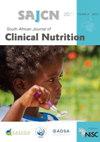Dyslipidaemia among HIV-infected children on antiretroviral therapy in Garankuwa, Pretoria
IF 0.6
Q4 NUTRITION & DIETETICS
引用次数: 4
Abstract
Objective: This study aimed to identify dyslipidaemia in human immunodeficiency virus (HIV)-infected children. This was part of a larger study aiming at the treatment of dyslipidaemia in this population. Design: A cross-sectional quantitative study design was used. Setting: The Paediatric Outpatient Department HIV Clinic at Dr George Mukhari Academic Hospital (Garankuwa, Pretoria). Subjects: Children who received antiretroviral treatment (ART) for at least six months and were virologically supressed. Outcome measures: Fasting lipograms were evaluated against American paediatric thresholds for dyslipidaemia (NCEP ATPIII guidelines), and z-scores for weight-for-age (WAZ) and height-for-age (HAZ) were interpreted. Results: In total, 140 children were enrolled, median age at enrolment was 64.5 months (interquartile range IQR 42.5–94.6) and 51% were female. Median period of ART use was 34.0 months (IQR 23.2–52.8). Median ART commencement age was 18 months (IQR 8.1–34.0). Lipid profile results were available in 108 of the 140 children. Total cholesterol was classified borderline in 33% and elevated in 11% of the children. LDL cholesterol was borderline in 24% and elevated in 7%. HDL cholesterol was borderline in 20% and low in 30%. Triglyceride levels were borderline in 29% and elevated in 39% of the children. Children were considered as having dyslipidaemia if one or more of the four lipid profile levels were abnormal, or if at least two were borderline. By these criteria, 75% of the group were dyslipidaemic. A significant negative correlation was found between dyslipidaemia and enrolment HAZ indicating stunting (r-value −0.31; p < 0.05), also between dyslipidaemia and months’ duration on ART (r-value −0.25; p < 0.05) and a significant positive correlation was found between initiation on protease inhibitor (PI)-based regimen and dyslipidemia (p < 0.05). Conclusion: The prevalence of dyslipidaemia in HIV-infected children receiving ART is high. Participants who were stunted, or had a shorter ART duration, and those initiated on a PI-based regimen were more likely to have dyslipidaemia.在比勒陀利亚加兰库瓦接受抗逆转录病毒治疗的艾滋病毒感染儿童中的血脂异常
目的:本研究旨在确定人类免疫缺陷病毒(HIV)感染儿童的血脂异常。这是一项旨在治疗该人群血脂异常的大型研究的一部分。设计:采用横断面定量研究设计。背景:George Mukhari博士学术医院的儿科门诊部HIV诊所(比勒陀利亚加兰库瓦)。受试者:接受抗逆转录病毒治疗(ART)至少六个月且病毒抑制的儿童。结果测量:根据美国儿科血脂异常阈值(NCEP ATPIII指南)评估禁食脂肪图,并解释年龄体重(WAZ)和年龄身高(HAZ)的z评分。结果:共有140名儿童入学,入学时的中位年龄为64.5个月(四分位数间IQR 42.5-94.6),51%为女性。抗逆转录病毒疗法的中位使用期为34.0个月(IQR 23.2–52.8)。抗逆转录病毒治疗的中位开始年龄为18个月(IQ 8.1–34.0)。140名儿童中有108名获得了脂质图谱结果。33%的儿童的总胆固醇处于临界水平,11%的儿童总胆固醇升高。低密度脂蛋白胆固醇在24%处于临界状态,在7%处于升高状态。高密度脂蛋白胆固醇在20%处于临界水平,在30%处于低水平。29%的儿童甘油三酯水平处于临界水平,39%的儿童甘油三酯升高。如果四种脂质水平中有一种或多种异常,或者至少有两种处于临界状态,则儿童被认为患有血脂异常。根据这些标准,75%的患者患有血脂异常。血脂异常与显示发育迟缓的登记HAZ之间存在显著负相关(r值-0.31;p < 0.05),也在血脂异常和ART持续数月之间(r值-0.25;p < 0.05),并且启动基于蛋白酶抑制剂(PI)的方案与血脂异常之间存在显著的正相关(p < 结论:接受ART治疗的HIV感染儿童血脂异常的发生率较高。发育迟缓或ART持续时间较短的参与者,以及采用基于PI的方案的参与者,更有可能出现血脂异常。
本文章由计算机程序翻译,如有差异,请以英文原文为准。
求助全文
约1分钟内获得全文
求助全文
来源期刊

South African Journal of Clinical Nutrition
NUTRITION & DIETETICS-
CiteScore
2.50
自引率
9.10%
发文量
21
期刊介绍:
1.The Journal accepts articles from all basic and applied areas of dietetics and human nutrition, including clinical nutrition, community nutrition, food science, food policy, food service management, nutrition policy and public health nutrition. 2.The Journal has a broad interpretation of the field of nutrition and recognizes that there are many factors that determine nutritional status and that need to be the subject of scientific investigation and reported in the Journal. 3.The Journal seeks to serve a broad readership and to provide information that will be useful to the scientific community, the academic community, government and non-government stakeholders in the nutrition field, policy makers and industry.
 求助内容:
求助内容: 应助结果提醒方式:
应助结果提醒方式:


